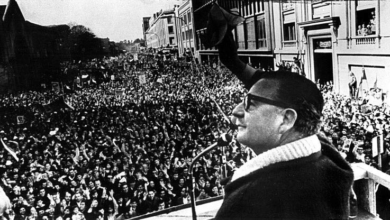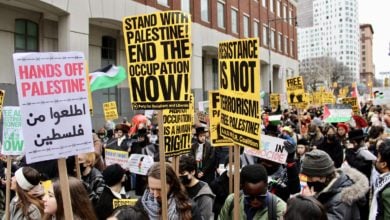This article was first published in the December 2006 issue of Socialism and Liberation magazine. Just 24 hours later, Colombian President Álvaro Uribe Vélez announced the end of fledgling discussions regarding
On Oct.19, a car bomb exploded at a military academy in Bogotá, Colombia, injuring 23 people and causing $171,000 in damage.
negotiations with the Revolutionary Armed Forces of Colombia-People’s Army (FARC-EP).

In a calculated move, he also ordered the military to attempt a rescue of 59 prisoners held by the FARC-EP. These prisoners are at the center of a humanitarian exchange proposed by the FARC-EP that would allow peace negotiations to move forward. On Oct. 22, 1,500 troops were sent into the mountains on the rescue mission. That mission, like many others before, failed.
Uribe’s provocative actions were condemned throughout Colombia. According to an Oct. 23 Interpress Service report, the humanitarian exchange has wide public support in Colombia. An editorial in the Colombia daily El Tiempo read, “Despite the indignation over the bombing, closing the door to an exchange and ordering a military rescue of the hostages would not appear to be the best route to take.” El Tiempo reflects the views of a wing of the Colombian ruling class.
The Colombian Senate passed a resolution on Oct. 23, demanding that the government reestablish contact with the FARC-EP and continue attempts toward peace negotiations.
On Oct. 24, thousands of Colombians protested Uribe’s decision to end the talks.
Carlos A. Lozano Guillén, director of Voz, the Colombian Communist Party’s weekly, claimed that the military academy attack was similar to previous attacks carried out by the Colombian military in August that were made to seem like FARC-EP attacks.
Bourgeois analysts agree that it is unlikely that the FARC-EP was responsible. Uribe has refused to reveal his supposed evidence.
Whether the attack was a deliberate maneuver or not, Uribe is taking advantage of the incident to end what had seemed to be a shift in his policy of all-out war.
On Oct. 2, the FARC-EP—the largest guerrilla force in the Western Hemisphere—had sent an open letter to the Colombian state setting the terms for negotiations between itself and the Colombian government.
The first issue is a prisoner exchange, an offer the FARC-EP has made for almost a decade. It is offering to free 59 prisoners held by the FARC-EP—Colombian police, military forces and members of congress, along with three U.S. defense contractors—if the government frees 500 imprisoned rebels. The revolutionaries are also demanding the release of two FARC-EP commanders, Simón Trinidad and Sonia, from U.S. prisons.
Other conditions include the creation of a demilitarized zone where the talks can take place, the suspension of orders for the arrest of the Central Command of the FARC-EP, recognition of the existence of the social and armed conflict and the removal of the FARC-EP from foreign states’ terrorist lists, among other conditions.
Uribe, recently elected to a second term, previously indicated a willingness to engage in negotiations. In August, he charged former minister and presidential candidate Álvaro Leyva to meet with the FARC-EP. In late September, he agreed to pull troops from two towns in south Colombia for 45 days.
The Colombian government’s shift of position in favor of negotiations was consistently accompanied by rhetoric supporting “democratic security”—code for all-out war.
The Colombian state, backed by Washington, has been trying to exterminate the revolutionary forces of Colombia—the FARC-EP, the National Liberation Army (ELN) and the militant social movements—for over 40 years. The state has carried out military attacks, covert operations and assassinations, and employed paramilitary death squads to repress the Colombian people’s struggle against the U.S-backed ruling class that dominates the country’s wealth.
At various times, different Colombian governments have tried to use negotiations with insurgents as a way to demobilize revolutionary struggles. For example, in the late 1980s, the Colombian government succeeded in co-opting the M-19 guerrilla force.
The Colombian state resorts to negotiations when it is on the defensive and needs to revitalize its forces for another offensive. The last round of negotiations with the FARC-EP, from 1998 to 2002, served this purpose. Following a series of FARC-EP victories, then-president Andres Pastrana granted the revolutionaries a demilitarized zone. During that time, the U.S. government poured over $1 billion in military funding and training to rebuild the decrepit and corrupt Colombian military forces.
But the revolutionary forces took advantage of those talks as well. The creation of a demilitarized zone for the talks strengthened the FARC-EP’s standing within the Colombian movement and with the Colombian people.
The demilitarized zone was a safe area the size of Switzerland where no paramilitaries or state forces were able to terrorize the Colombian people. The FARC-EP organized a series of events, called “public audiences,” where hundreds of Colombian workers, peasants, Indigenous people and others were able to put forward their demands for a new Colombia. The talks brought international attention to the Colombian people’s struggle for justice.
The FARC-EP has consistently called for a political solution to the social and armed conflict. This conflict has its roots not in armed violence but in capitalist exploitation and oppression. The FARC-EP has consistently resisted the demands of the Colombian state to demilitarize until those basic factors are addressed.
The ELN is already engaged in peace talks with the Colombian government in Cuba. On Oct. 26, during the fourth round of exploratory talks, the ELN and the Colombian government agreed on a framework for peace negotiations.
According to Reuters, they agreed to discuss amnesty for the rebel group’s members, the release of prisoners held by the ELN and a humanitarian deal for millions of refugees displaced by violence. The talks stalled on the issue of a ceasefire.
‘Plan Patriota’
Since he took power in 2002, Uribe’s policy has been to carry out an all-out expansion of the war, refusing to consider
 The FARC-EP is demanding the freedom of 500 imprisoned rebels, including Simón Trinidad, pictured above. Photo: AFP Photo/STR |
The Washington Office on Latin America, no friend to the Colombian armed resistance, called the plan “the most ambitious counter-insurgency effort ever undertaken by the Colombian military.” The plan primarily targets the peasant population that forms the FARC-EP’s rural base.
While the FARC-EP initially retreated in the face of this offensive against the population, it began a new military offensive in February 2005. That offensive showed that Plan Patriota is not having its desired consequence—the FARC-EP and the Colombian social movements are still strong.
The inability to accomplish the destruction of the revolutionary movement has been a decisive factor in the Colombian state being forced to explore alternative options.
The Colombian state is in a crisis. The Colombian military—the institution carrying out the war on the people—has been rocked by scandals further endangering its shaky legitimacy. Fourteen soldiers and a colonel are being tried for murdering police agents while acting under the orders of a main drug trafficker. The press has reported that the military has carried out attacks made to look like rebel attacks.
In September, the chief federal prosecutor’s office opened an investigation on 14 soldiers accused of killing civilians, whom they claimed to be rebels. According to the Judicial Freedom Corp., 107 cases of extrajudicial killings were recorded in Antioquia State between 2002 and 2005.
Elkin Ramirez, a lawyer for the Judicial Freedom Corp., said, “There’s a pressure on these army units to produce results, to be the most active in killing guerrillas. This comes right from the top, from the presidency.”
Beginning in 1998, the U.S. government under Clinton implemented what it called “Plan Colombia,” a total aid package that made Colombia the third largest recipient of U.S. military aid in the world, behind only Israel and Egypt. Under this plan, the U.S. government provides $600 million every year to Colombia. It has sent more than $4.7 billion since 2000.
The purpose of this funding has been to revamp the corrupt conscript Colombian military.
According to the Christian Science Monitor, Colombia received $18 million in 1989 for military and police assistance. One year later, military funding increased five-fold. This coincided with the first revamping of the Colombian military and intelligence services under the direction of the U.S. government.
Since 2000, the U.S. embassy in Bogotá has grown into the second largest U.S. diplomatic mission in the world, after Baghdad. It employs over 2,000 people.
It is no coincidence that Uribe’s backtracking on the issue of the humanitarian exchange and his announcement of a military rescue mission came just days before an Oct. 24 U.S. State Department delegation visit to Colombia. The U.S. government has stated its opposition to any talks with the FARC-EP, which it demonizes as “narco-terrorists.”
The Uribe government relies entirely on the backing from the U.S. government and Pentagon for its support. It has repeatedly carried out Washington’s wishes both in Colombia and in the region—even when those wishes contradict the interests of the vast majority of Colombians, and even the interests of sectors of the Colombian ruling class.
But this lackey role puts the Colombian ruling class in direct and open conflict with wider layers of Colombia’s working class and peasantry. The FARC-EP has carried out bolder attacks against the murderous government’s police and military units. And on Nov. 10, hundreds of thousands of Colombian workers took to the streets against the Uribe government’s plans to sign a Free Trade Agreement with the United States.
That conflict raises the question: How long can the U.S.-backed Colombian regime resist the wave of anti-imperialist mobilizations that are sweeping Latin America?






